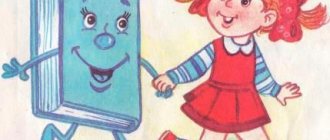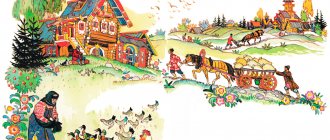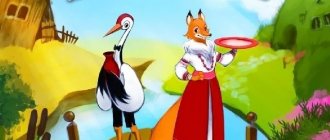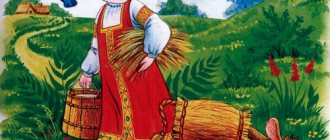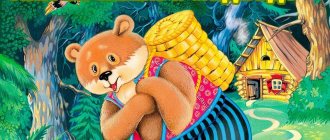Although games in Rus' have always been considered fun, our ancestors attached great educational importance to them. Where else, if not in a game, does a child learn about the world, relationships between peers, relationships between elders and younger ones, learn to follow the rules and obey them.
Nowadays everyone knows that play is the basis of a child’s life. Psychologists say that through it the baby receives the necessary knowledge and skills. Thanks to the game, he develops as a person and acquires social skills. Everyone understands this very well, but often parents do not find the opportunity to actively play with their children. A lot of interesting children's entertainment has been replaced by a computer. Unfortunately, psychologists have recorded the fact that the influence of play on a child’s personality is weakening for various reasons.
The usefulness of folk games
Caring parents, aware of their busyness and inability to fully communicate with their child, try to surround him with a variety of toys. This is good, since the baby should have the opportunity to explore the world around him through the toy. But, more often than not, everything ends with the purchase of toys because adults consider their mission completed. Meanwhile, for a preschooler to play, he must be taught to do so. When a baby can play independently, then he will not need a large number of toys.
What are the best games to offer to children? How to find a game that will unite an adult and a child? Russian folk games will help solve these questions. They have been selected for centuries, and the most beloved and popular ones have come down to us, which are easy to organize in any setting: on vacation, at home. The time has come for modern parents to find out what games their great-grandfathers played and how they are useful for our children.
"Takiya tastamak"
The game “Throw the Skullcap” will teach your child patience and endurance. Use a counting rhyme to select a leader. Give him a skullcap or any other hat. Place the children in a wide circle:
- The host announces the start of the game with the phrase “Throw the skullcap.” After this, children cannot look back and spy.
- The presenter walks behind them and says: “Slowly and quietly I will go around everyone and quietly place a skullcap on someone. If you don’t notice it, I’ll beat you with it, and you’ll become the leader.” During the process, the headdress is left behind someone's back.
- When the leader’s phrase ends, the children begin to fumble with their hands behind their backs. The one who felt the skullcap runs after the leader and tries to put the headdress on him.
- The chase lasts to the place of the player who found the skullcap. If he does not have time to put it on the presenter, then he takes the hat away. Then he lightly hits the pursuer with it, and he becomes the leader for the next round.
Holiday fun
Even in ancient times, folk games were united into different groups. They differed in purpose, number of participants, complexity of the rules, and age of the children. However, most folk games are so unique that each of them, according to its characteristics, can be included in any group.
For ease of use, you can divide all games into holiday and everyday ones. Festive folk games for preschoolers are good because they bring a lot of fun and entertainment to the participants. Preschoolers enjoy the gameplay itself, the opportunity to communicate with peers or older children without any conventions.
Such entertainment contains a minimum number of simple rules that are easy to follow, so they are great for various types of celebrations when many children gather: birthdays, family celebrations, holiday events.
Russian folk games for children are easy to participate in, since they contain simple plots, familiar characters act there, and the rules are clear and accessible to children. All this arouses interest among preschoolers and a desire to take part in a common game.
In addition, in the age of computers, when there is a lot of talk about poor posture in children, a sedentary lifestyle that causes all sorts of diseases, folk games are an excellent opportunity to encourage children to move, to develop in them such qualities as ingenuity, dexterity, dexterity, and resourcefulness. Another positive side of such entertainment is that children of different ages can participate there, from toddlers to high school students.
"Towns"
First, a small lyrical digression. About 8 years ago, when my husband was actively involved in organizing various holidays, and I was helping him, we organized a corporate party on the occasion of the anniversary of a small company. The holiday was themed, on the theme of sports. That is, the host of the party was also the head coach, and everyone present at the celebration were, like, athletes.
We then arranged many different sports locations, fortunately the location allowed, since we held the entire event outdoors. And one of the locations was dedicated to the game of gorodki. She was the most popular. Adults frolicked like children with these bats and tried to hit the wooden cylinders arranged in various shapes. And when it worked out, the joy knew no bounds!
If adults were so carried away, then how should school-age children react to this game?
And if it’s difficult to get ruffles these days, then I think there won’t be any problems with sets for towns.
I am sure that you are familiar with the rules of the game in small towns. Therefore, I’ll just remind you what shapes can be made from small wooden sticks, which, by the way, are called towns.
What interesting games should you offer children?
Preschoolers and children can take part in the universal fun “Rooster Fight”, “Cockerels and Hens”, “Ducks and Geese”, “Trap with a Goat”, “Bear in the Forest”, which reflect the living world in their themes and imitate the habits of animals older guys. Everyone loves games that give them the opportunity to run wild and show off their resourcefulness. They actively develop motor skills and acquire new skills.
Game "Cock Fight"
In the fun “Cock Fight,” the players, with their legs tucked in, trying to maintain balance, push each other with their shoulders.
The winner is the player who forces his opponent to his feet.
Game "Cockerels and Hens"
The fun “Cockerels and Hens” is a pair game, which allows the child to feel responsible for his peer. Teaming up in twos, over a certain period of time, players collect large seeds (for example, pumpkins) scattered on the ground.
The winners are the players who collect the most beans.
You can also look at old-time running entertainment.
Game "Bear in the Forest"
The fun “A Bear in the Forest” is a classic of the genre, well known to both big and small, and has firmly entered the curriculum of preschool institutions. To play the game, two lines are drawn on opposite sides of the court. One has a driver, imitating a sleeping bear, the other has the rest. The adult gives a signal, and the preschool children slowly, “picking mushrooms and berries,” go to the “bear.” You can't run until all the words have been said. The quatrain accompanying the players’ actions is simple, easy to remember, and therefore pronounced in chorus:
“The bear has mushrooms in the forest, I pick the berries. But the bear is not sleeping, he’s still looking at us! "
The end of the rhyme is a signal to the “bear” who is running after the children. He catches players until they reach his line. Then the child who was caught drives.
For variety, you can use a more complex nursery rhyme:
“I pick mushrooms and berries from a bear in the forest. But the bear is not sleeping, he is still looking at us. And then he growls and runs after us! But we take the berries and don’t give them to the bear. Let's go into the forest with a club and hit the bear in the back! "
Game "Ducks and Geese"
The “Ducks and Geese” entertainment helps children show restraint and dexterity, since according to the rules, they must walk to the goal at a “duck pace.” When playing, participants form a circle with their hands behind their backs. With a ball in his hands, the driver walks in a circle and says the word “duck” several times, then, unexpectedly for everyone, changes the word, saying “goose.” The ball is quickly placed in the hand of one of the players. Then the driver and the child with the ball go left and right, moving towards each other in a circle. Everyone strives to be the first to reach the “empty” place where the movement began. When meeting, the players greet: “Good morning (afternoon, evening)! "
The player who comes first wins. The leader is the one who came last.
Game "Trap - goat"
The outdoor game “Trap - Goat” consists of traditional content and rules that are found in any similar game. As an option, you can use the image of different animals, for example, “Trap is a wolf.” A “goat” is selected, the players say a nursery rhyme: “The little goat is gray, the tail is white, We will give you something to drink, We will feed you, Don’t butt us, But play with the trap.” Having said the quatrains of the nursery rhyme in chorus, the players run away, and the “goat” catches them, trying to “gore” them, imitating the movements of the animal.
Taking into account the age of the kids and their interests, similar games can always be found in different sources.
"Oramal"
Many national games (and Kazakh ones are no exception) teach children the most necessary skills. This is about:
- speed of reaction;
- attentiveness;
- ability to work together.
“Oramal”, or “Scarf”, is just such a game. First, choose a driver. He takes a handkerchief (handkerchief or any other) and ties a large knot on it:
- All players line up in a circle with the driver in the center. The latter gives a handkerchief to one of the participants.
- The player who received the handkerchief has the right to give it to any other player, but only at the time of pursuit.
- Then the children begin to walk in a circle, and the driver counts to three. On “three” the participants scatter.
- The driver needs to notice where the player with the scarf ran, catch up with him and touch him on the shoulder. After that, he takes the scarf and makes a wish (to dance, read a poem, etc.).
- The player who had the scarf takes the place of the driver.
Traditional Russian fun
On holidays, among Russian folk games, entertainment with a large number of participants was popular, when they could divide into groups and compete with each other. From time immemorial, games with a competitive element have been loved by children of different ages, as they provide an opportunity to test their strength, luck, and dexterity. Such traditional Russian games include “Burners”, “Pull the String”, “Chains” and similar ones.
Game "Drag the String"
In the game “Pull the String,” two hoops are placed on the sides of the court. A rope is stretched along the ground so that its ends are in the middle of each hoop. Preschool children are divided into two groups. The participants of each of them, in turn, stand in their hoop, then, at a signal from the driver (an adult or an older child): “One, two, three, run!”, they change hoops, trying to reach the opponent’s place as quickly as possible and pull the rope. The one who completes the actions faster and without errors becomes the winner. Following the first pair, the second runs, then the third, and so on until the end.
The team whose members were faster and pulled the rope more often wins. An adult must participate in this competition to ensure that the rules are followed.
Game "Burners"
In the classic game "Burners", players stand in pairs in a column. Raised hands form a “gate” through which all couples pass. In front of everyone, with his back to the other players, stands the driver, who is also called the “burning one.” The players say the nursery rhyme in chorus: “Burn, burn clearly, So that it doesn’t go out! Look at the sky, Birds are flying, Bells are ringing. Ding-dong, ding-dong, quickly run out! " At the last words, the children in the pair in front scatter in different directions, the rest shout in unison: “One, two, don’t be a crow, but run like fire!” “The driver turns around and catches up with the fleeing children.
If the players manage to take each other’s hands, and the “burning” one is left with nothing, then they again stand behind the column. The driver again catches or “burns” another pair: the game is repeated.
If it is possible to catch one of the fleeing players, then a new pair is formed. The player who is left without a pair becomes the driver.
Game "Chains"
In Chains, players also form two teams. With a little counting table, for example: “A cuckoo walked past the net, And behind it were little children. The cuckoos are asked to drink. Come out - you'll drive! ", select the "breaker" who will break the "chain". The teams are located opposite each other, the participants hold hands tightly. The driver scatters, runs towards the “chain” of opponents, trying to destroy it.
If successful, he takes the opponent to his group; if it doesn’t work out, he himself remains with the opponents. The team with the most players is the winner.
Quite a lot of similar entertainment has been collected and stored in the national treasury. Most of them are relevant and loved today, for example:
- "Geese-geese";
- "Hide and Seek";
- "Cossacks-robbers";
- "Salki";
- "Blind Man's Bluff";
- "Ring".
Others - “Pleten”, “Ringer”, “Lapta” and others are half-forgotten, have more complex rules that need to be memorized with the children first. Every parent can prepare exciting games, fun, and entertainment for children's parties. It all depends on the interest and desire of the adults themselves.
"Goats"
Kazakh national games are varied. “Kozy”, or “Lamb”, develops the child’s memory and hearing. The game is a team game, but does not require much space:
- Divide the children into two “flocks”—these are “lambs.”
- Choose two leaders - “shepherds”.
- Groups sit close to each other.
- The “shepherd” approaches his opponents and utters the phrase: “He walked quickly, he walked quietly, he came to beg for a lamb.” The second “shepherd” offers to choose a suitable one from his “flock”.
- The first “shepherd” points to one of the players and covers his eyes with his palm. After this, a player from the other team must bleat loudly without changing his voice.
- The child, whose eyes are covered, is asked to identify the one who said “Be-e.”
- If the guess is correct, then the person shouting is taken to the opposing team. Otherwise, the first “shepherd” takes the guesser.
The group with the most people in the end wins.
Kazakh national games for children: YouTube/Natalia Natalya
Folk games in the daily life of a preschooler
For everyday leisure, you need to choose games that the child could play on his own, but even in them the gameplay should captivate him. The following activities will help:
Game "Male-Kalechina"
The fun “Malechina-Kalechina” is an ancient game. According to the rules, for the action they take a smooth stick, which they place vertically on the tip of the finger and begin to count: “Male china, how many hours until evening?” One two Three…" . Count until the stick falls. Alternatively, the wand can be placed on the palm, forearm, or knee. When falling, the stick should be caught with the other hand to continue the action.
This game is useful for developing motor skills, dexterity, and perseverance in preschoolers.
Game "Spillkins"
Traditional folk entertainment is “Spillikins”, small wooden sticks or figurines. The player uses two fingers or a special hook to grab a figure without touching the neighboring sticks. The child must be encouraged to strive diligently to choose the figures. Some children lack patience.
This kind of fun develops perseverance and fine motor skills, which is very important for a child.
Game "Fanta"
The famous game “Fanta” is very exciting for preschoolers if they know how to play it. It does not require special space or equipment. Useful for preschool children, as it entertains and helps develop memory, speech, and imagination. An adult can play with a child. The presenter begins: “They sent you a hundred rubles, Buy what you want, Don’t take black, don’t take white, Don’t say no!” The child listens carefully to the questions and tries not to use forbidden words when answering. For example, to the question: “Are you going to the ball? “, you can answer: “I’ll go.” Sample questions and answers could be in the old style: “What dress will you wear? ‒ I’ll wear a beautiful dress”, “Will you go in a carriage? “I’ll go on foot.” Or modern: “Are you going to the bakery? Will you buy bread there? " If a player gets confused, he gives the leader a forfeit (any item), and then at the end of the game he “buys back” it. To “redeem” forfeits, you can invite the preschooler to sing a song, read a poem, or use other exciting tasks.
Game "Hide and Seek"
Children especially love the traditional game “Hide and Seek”, the content and rules of which are well known to everyone. It can be organized outdoors and at home. To keep kids interested, a nursery rhyme is used: “One, two, three, four, five, I start looking. Whoever didn’t hide is not my fault. Whoever stands behind me has three horses to drive.” Then everyone hides, and the leader tries to find him. Choosing another presenter may have several options. For example, the leader can be the participant who was discovered first, or use a counting rhyme.
Rhymes and counting rhymes, which are an integral part of fun, one might say their calling card, help to captivate preschoolers, develop their speech skills and imagination. Therefore, when choosing folk games, it is better to give preference to those with folklore.
From the list of games presented, it is clear that, despite the simplicity in plots, rules, and actions, many educational issues are resolved. When a preschooler learns the rules of the ancient game, he will enjoy playing it. Much depends on the parents, who can captivate the child with folk games.
"Ryuhi"
Before I explain to you the rules of this ancient game, I’ll tell you what ryukha is. Ryuha is a piece of wood. In order to make a ripple, you need to cut a thin log into pieces 20 centimeters long. The larger the ripple, the more interesting it is.
Also, for the game you will need at least two sticks with a diameter of approximately 5 cm and a length of approximately 1 meter.
Everyone who wants to play is divided into two teams. Each team draws a square measuring 1.5 x 1.5 meters on sand or asphalt. And in these squares, each team builds its own city. He makes various figures from ryukh. It is important that the squares are located on the same side, this is for safety.
The horse line is also drawn. This is the line behind which the teams will be located, and because of which they will throw long sticks trying to destroy the enemy’s city and knock all the creatures out of the drawn squares. This is an eco-game. All equipment is environmentally friendly! Yes, and children spend time outdoors.
Again the question arises: “Where can I get ryukhi?” Residents of rural areas have a chance to acquire them; they are lucky. What should city kids do? Well, of course, replace the game of “ryukhi” with the game of “towns”.
"Kumis alu"
The game "Collect Silver" improves alertness, speed and endurance. It requires a spacious area and many small items. Make a start at one end of the site, and place the finish line on the opposite side.
Then play like this:
- Place the children at the starting line. Scatter small objects throughout the playing area.
- At the signal, the races begin. Children need to pretend to ride horses and, without stopping for a second, collect “coins” from the floor, moving towards the finish line.
- The one with the most items at the finish line wins the competition.
- During the races, you must not push, stop, or interfere with other participants.
Kazakh national games for children are very diverse: YouTube/Alfiya Yemelyanova
Kazakh national games are very diverse. Some train children's accuracy and strength, others help them become more dexterous and smart. Thus, in the gaming heritage of the Kazakh people it is not difficult to find fun for every taste.
Original article: https://www.nur.kz/leisure/entertainment/1652194-kazakhskie-nacionalnye-igry-dlya-dete/

